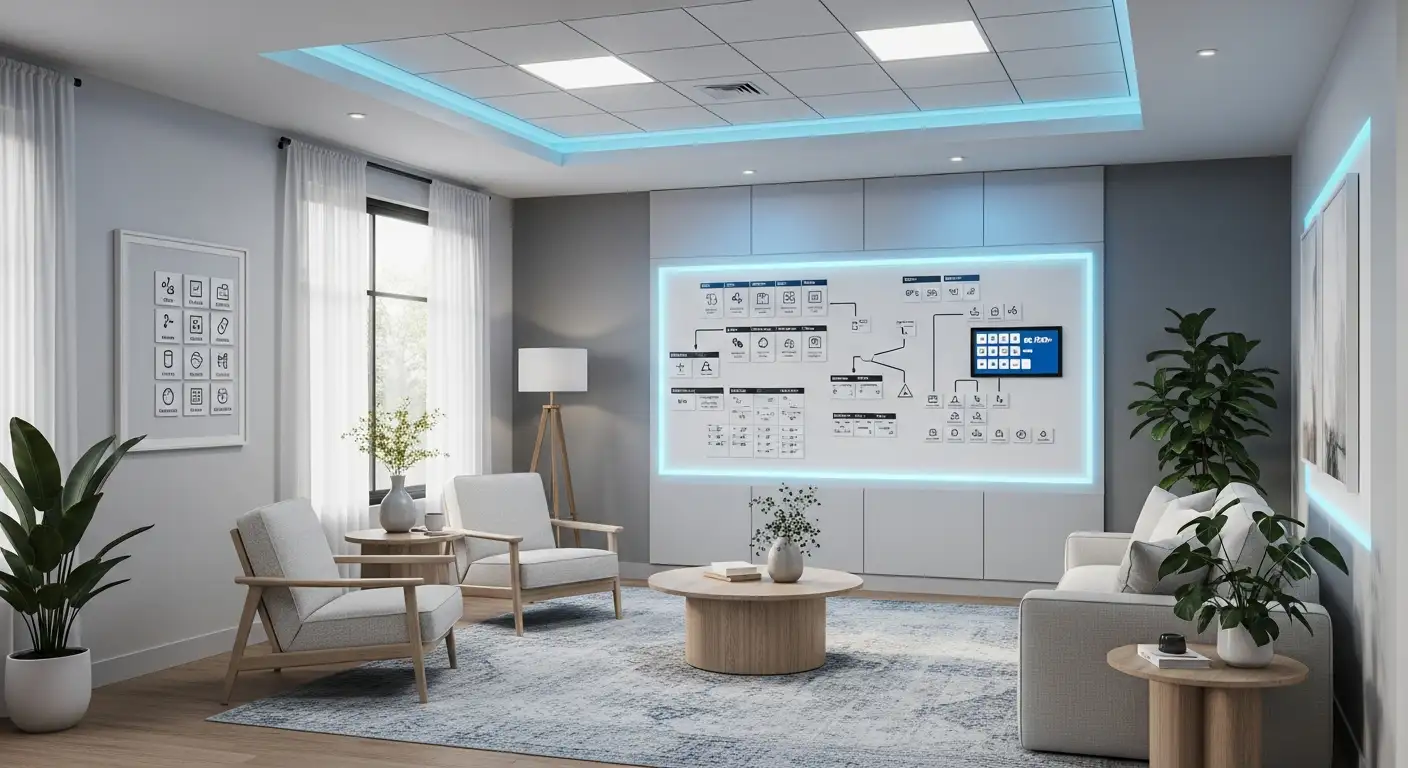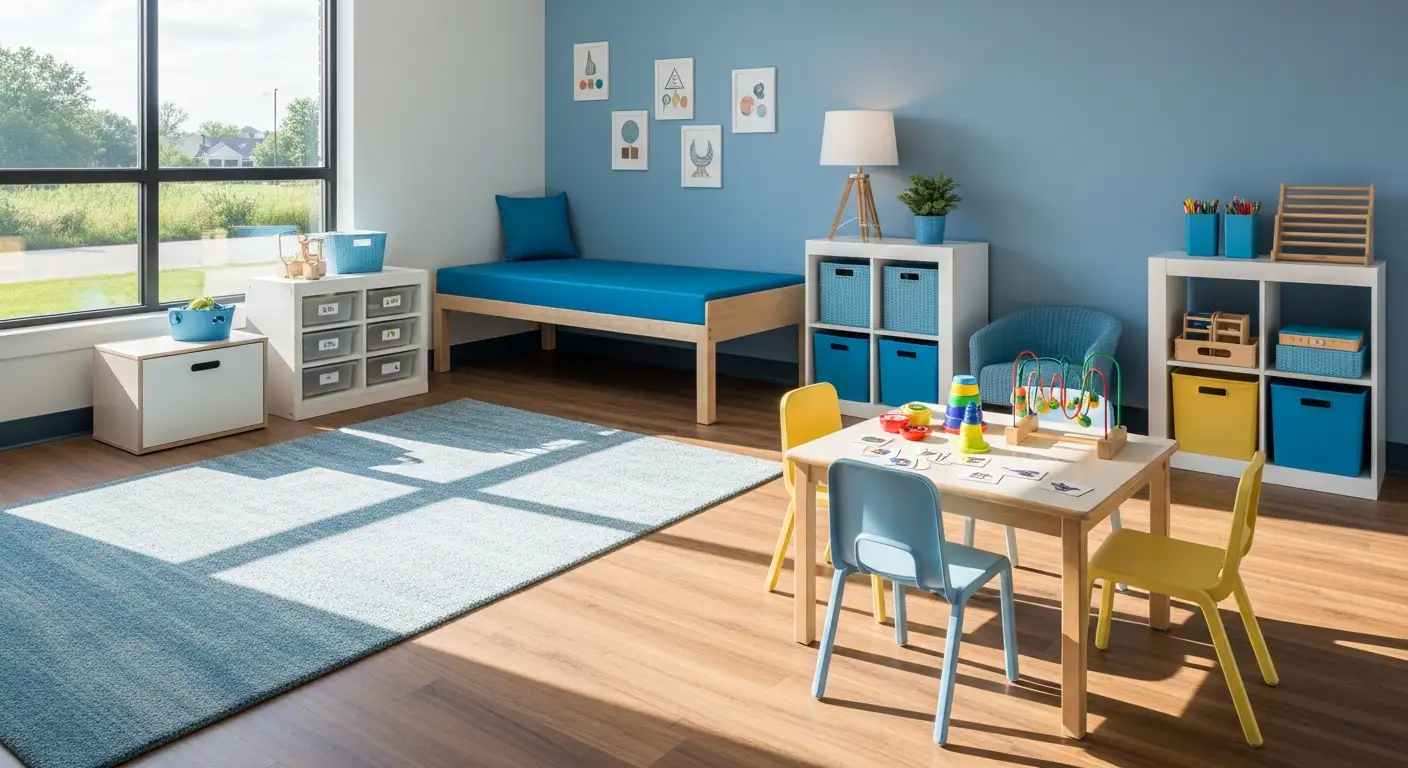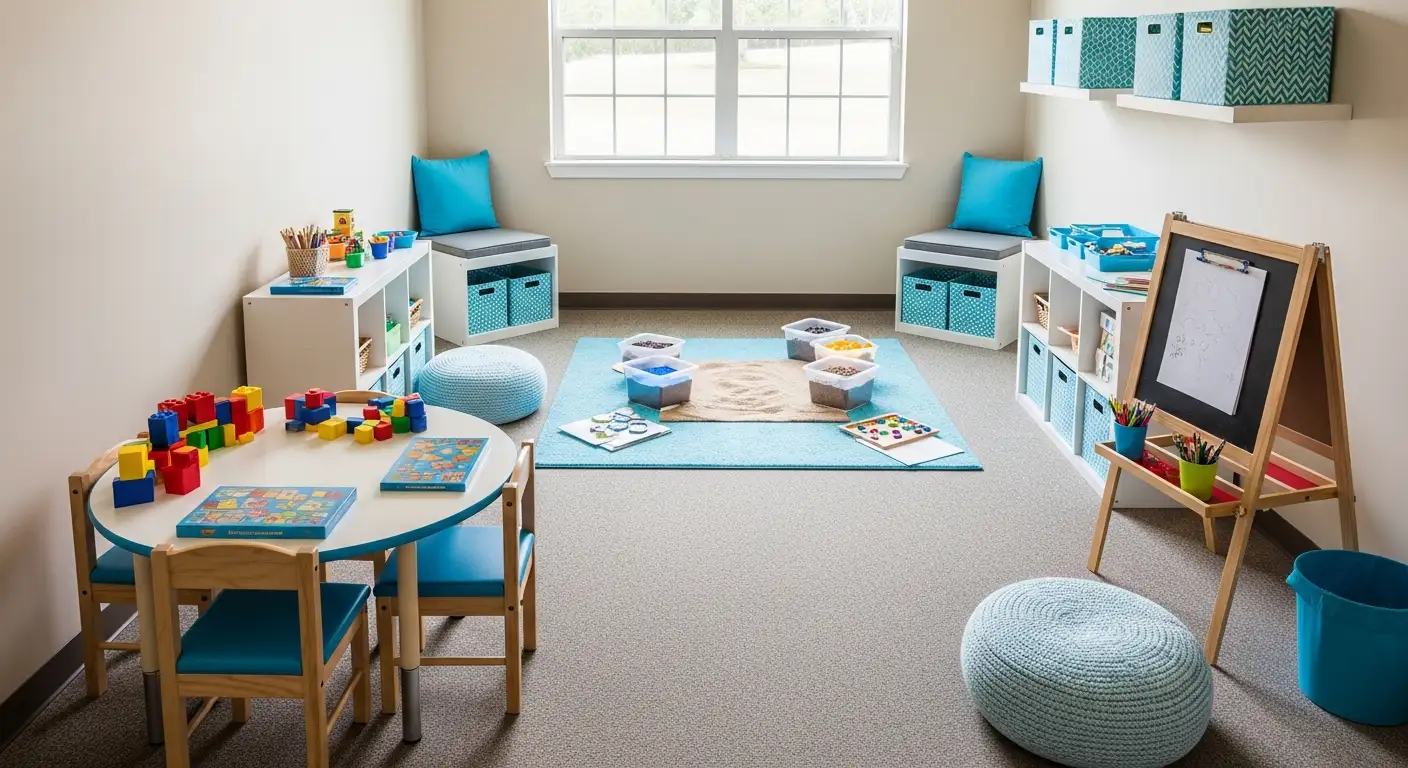The Role of Visual Supports in Enhancing ABA Therapy Outcomes

Understanding Visual Supports in ABA Therapy
Visual supports have emerged as a crucial component in Applied Behavior Analysis (ABA) therapy for individuals with Autism Spectrum Disorder (ASD). These tools provide structure and clarity, helping children with autism to better understand their environment and improve communication. This article delves into how visual supports can enhance therapy outcomes, the types of supports available, evidence of their effectiveness, and practical strategies for implementation.
Defining Visual Supports in ABA

What are visual supports in the context of ABA therapy for autism?
Visual supports in ABA therapy for autism are visual tools and strategies designed to enhance understanding and communication for individuals with autism spectrum disorder (ASD). These supports can take the form of visual schedules, social stories, choice boards, and graphic organizers, all aimed at improving comprehension and engagement during therapy.
For many children with ASD, especially nonverbal individuals or those with limited vocabulary, these visual aids serve as essential communication tools. They provide clear visual cues that make it easier for children to express their needs, understand social interactions, and follow routines.
Purpose of visual supports in ABA therapy
The primary purpose of visual supports in ABA therapy is to create a structured and predictable environment that reduces anxiety and frustration. By offering consistent visual information, these supports help children navigate daily activities and transitions more smoothly.
- Enhance communication: Visual supports allow individuals to express themselves effectively when verbal communication may be challenging.
- Promote independence: Tools like visual schedules foster autonomy by guiding children through tasks, allowing them to manage activities with less adult assistance.
- Improve understanding: They simplify abstract concepts, making skills more accessible during therapy sessions.
- Reduce anxiety: By creating a predictable framework, visual supports alleviate stress associated with daily changes and expectations.
In sum, visual supports play a crucial role in facilitating effective learning and communication for individuals with autism in ABA therapy.
Impact of Visual Supports on Therapy Effectiveness

How do visual supports enhance the effectiveness of ABA therapy for individuals with autism?
Visual supports play a critical role in enhancing the effectiveness of Applied Behavior Analysis (ABA) therapy for individuals with autism. They provide concrete methods for communication and understanding, which are invaluable for children who may struggle with abstract concepts. Examples of these tools include visual schedules, social stories, and token boards, each serving unique functions.
By simplifying information, these supports make complex tasks more manageable. For example, visual schedules outline daily routines, which help children grasp sequential events and manage their time effectively. Social stories present specific social situations, aiding children in developing better social skills and responses.
Moreover, visual supports draw upon the visual strengths often observed in individuals with autism, aligning instructional methods with their cognitive profiles. This approach not only encourages independence but also fosters confidence in navigating tasks without constant adult support.
Role in communication and anxiety reduction
The communication benefits of visual supports cannot be overstated. They offer alternative means of expression for non-verbal children, facilitating their ability to communicate needs and thoughts effectively. Visual aids, such as choice boards, provide opportunities for children to articulate preferences, enhancing their engagement and participation.
Additionally, visual supports are instrumental in reducing anxiety by establishing predictability in routines. A structured environment brought about by these tools promotes a sense of security. When children know what to expect, they are less likely to feel overwhelmed, which can lead to improved focus and participation in therapy sessions. Ultimately, the integration of visual supports is vital in fostering a supportive atmosphere conducive to learning and growth.
A Closer Look at Types of Visual Supports
What types of visual supports are commonly used in ABA therapy?
Visual supports play a significant role in enhancing the effectiveness of ABA therapy for children with autism. They provide clarity and structure, making learning more accessible. Some common types of visual supports include:
- Visual Schedules: These outline the sequence of tasks, helping children anticipate what comes next in their routines.
- First-Then Boards: These show the first task that needs to be completed before the next can begin, aiding in following instructions.
- Choice Boards: These enable children to make decisions about activities or tasks, promoting independence.
- Visual Timers: These help children understand the duration of tasks, reducing anxiety surrounding transitions.
- Social Stories: These are personalized narratives that help children navigate social situations and improve their interpersonal skills.
Additional examples include tactile symbols and visual reminders, which further support comprehension and navigation of daily activities. Task sequence instruction strips and visual checklists enhance task completion by providing step-by-step guidance. Contingency maps and mini-schedules are also effective tools that clarify expectations and support smoother transitions between tasks.
Functions of Each Type
| Type of Visual Support | Function | Benefits |
|---|---|---|
| Visual Schedules | Organize and structure daily activities | Enhances understanding of routines |
| First-Then Boards | Clarify task sequence | Reduces anxiety over what comes next |
| Choice Boards | Facilitate decision-making | Promotes autonomy and preference expression |
| Visual Timers | Indicate task duration | Helps manage transitions and expectations |
| Social Stories | Teach social interaction skills | Aids in navigating social situations |
| Tactile Symbols | Provide tactile engagement | Improves communication for non-verbal children |
| Visual Reminders | Offer cues for tasks | Reinforces learning through visual prompts |
| Task Sequence Strips | Guide children through tasks | Promotes completion and understanding |
| Visual Checklists | Monitor completion of tasks | Encourages independence and self-management |
| Contingency Maps | Clarify options and outcomes | Facilitates smoother decision-making |
| Mini-Schedules | Provide condensed task representations | Helps in managing complex situations effectively |
The range of visual supports not only aids in communication but also fosters independence and reduces anxiety for children, ultimately enhancing their overall learning experience.
Implementing Visual Supports: Strategies and Examples
Practical Implementation of Visual Supports
Visual supports in ABA therapy are essential tools that enhance communication and understanding among individuals, particularly those with autism spectrum disorder (ASD). Implementing these supports can significantly improve therapy outcomes. Here are some practical examples:
- Personalized Visual Schedules: These schedules outline daily activities in a clear, sequential manner, helping children anticipate what comes next.
- First-Then Boards: This tool illustrates a sequence of tasks, such as showing a child that they will complete a chore before getting to play, reducing anxiety around transitions.
- Choice Boards: These boards allow children to make choices among preferred activities, facilitating communication and agency.
- Checklists for Routine Tasks: Visual checklists can help children track steps in a task, promoting independence in following through with routines.
- Visual Boundaries: These tools define activity spaces, which aids children in understanding where specific tasks are meant to take place.
- Reward Systems: Token boards can motivate positive behaviors by visually tracking rewards for completing expected tasks.
- Change Cards: These can help ease transitions by visually preparing children for changes in activities or environments.
- Adapted Books: Using visual narratives engages children and helps them comprehend complex social situations in a more relatable manner.
Real-World Examples
Implementing visual supports requires tailoring to each child’s individual needs and preferences. For instance, a child might benefit from a personalized visual schedule that aligns with their daily routine, enhancing their understanding of expectations. Another example includes using social stories that specifically address unique social situations a child faces, providing relatable scenarios they might encounter in day-to-day life.
By carefully assessing the needs of persons with autism and consistently integrating these visual supports across various settings—like home, school, and therapy sessions—caregivers and educators can promote a more effective and supportive learning environment.
The Science Behind Visual Supports
Evidence-based benefits
The efficacy of visual supports in enhancing outcomes for individuals with autism in Applied Behavior Analysis (ABA) therapy is well-documented across various studies. These tools simplify the learning process by turning abstract concepts into concrete visuals. By doing so, they help boost communication skills, social interactions, and behavior management.
Studies suggest that visual supports also reduce anxiety by promoting predictability in routines, which is critical for children on the autism spectrum. Clinical guidelines consistently recommend their integration, particularly in educational settings, due to their ability to create a more structured and supportive environment.
Research findings
A review of 34 studies reveals that visual supports are linked to improvements across numerous skill areas, including social skills, communication, and academic performance. For instance, preschool-aged children using a visual cue to request participation in play demonstrated a noticeable increase in language use, alongside reduced off-task behavior.
Furthermore, qualitative data collected from parents underscore the importance of personalized visual supports. Families reported greater access to resources and enhanced confidence in implementing strategies at home. Overall, adaptations incorporating these supports into therapy lead to better performance in assessments, particularly in developing motor skills.
| Type of Support | Function / Benefits | Outcome Improvement |
|---|---|---|
| Visual schedules | Help manage daily activities | Enhances understanding of routines |
| Token boards | Reinforce positive behavior | Increases motivation and compliance |
| Social stories | Aid in navigating social situations | Improves social skills |
| Visual cues | Guide through specific tasks | Supports skill development |
In summary, implementing visual supports not only fosters communication and independence but also significantly enriches the overall effectiveness of ABA therapy.
Visual Supports: Tools of Communication
How do visual supports aid in communication for nonverbal children?
Visual supports play a transformative role in enhancing communication for children with autism, especially those who are nonverbal. They provide essential tools that help express thoughts and needs without relying solely on spoken language.
Visual aids can take various forms, including pictures, symbols, and written words. For example, a simple graphic symbol representing ‘Can I Play?’ has shown significant effectiveness in helping children initiate interactions during play. This use of visual supports creates communicative opportunities and encourages engagement.
Another important type of visual support is social stories, which outline social situations and expected behaviors. These stories simplify complex social concepts into understandable narratives, directly aiding communication.
Moreover, visual schedules and token boards are vital tools that clarify expectations and reinforce positive behavior. They help children follow routines, leading to an increased understanding and expression of their needs. This structured approach not only alleviates anxiety but also boosts their confidence in communication situations.
In summary, visual supports are invaluable in bridging communication gaps for nonverbal children, allowing them to navigate interactions more independently and effectively.
Visual Supports in Reducing Anxiety
Role of Visual Supports in Creating Predictability and Reducing Anxiety
Visual supports are vital tools in addressing anxiety for children with autism spectrum disorder (ASD). By offering a clear representation of routines and expectations, they create a structured and predictable environment. This predictability is crucial, as uncertainty can often heighten anxiety levels in children with ASD.
Utilizing visual tools, such as visual schedules and first-then boards, allows children to anticipate what comes next in their day. This anticipation can significantly alleviate feelings of stress. For instance, knowing that a favorite activity follows a less preferred task can provide motivation and reduce resistance.
Moreover, the presence of visual parameters helps children understand social situations better. They establish boundaries and clarify expectations, ultimately fostering confidence. When children know what behavior is expected of them, they are less likely to feel overwhelmed.
Additionally, personalized visual supports can cater to individual needs, ensuring a better fit for different children. This tailored approach not only minimizes anxiety but also promotes participation and engagement.
| Type of Visual Support | Function | Impact on Anxiety |
|---|---|---|
| Visual Schedules | Outline sequences of daily activities | Provides predictability |
| First-Then Boards | Clarifies task sequences | Reduces uncertainty |
| Social Stories | Help navigate social interactions | Improves understanding of social cues |
| Visual Cues | Directs specific behaviors | Establishes clear expectations |
In summary, implementing effective visual supports can play a crucial role in minimizing anxiety for children with autism. When used consistently across different settings, these supports can enhance overall therapeutic outcomes.
Independence Through Visual Supports
Promoting Independence with Visual Aids
Visual supports play a significant role in fostering independence among children with autism. By using tools such as visual schedules, token boards, and social stories, children can navigate their daily activities with greater autonomy. These visual aids present information in a clear and structured manner, helping children understand task sequences without relying heavily on adult prompts.
One common example is the use of visual schedules, which outline the steps involved in routine activities. This clarity allows children to foresee what comes next, thereby alleviating anxiety about transitions and unexpected changes. When children know what to expect, they are more confident in managing tasks independently.
Additionally, token boards serve not only as a method for reinforcing positive behavior but also empower children by providing them with control over their accomplishments. In this way, visual supports contribute to a sense of agency and self-management.
Overall, the effective implementation of these tools can significantly enhance the independence of children with autism, providing them with the skills they need to navigate their environment with confidence and clarity.
Visual Supports in Educational Settings
Application of Visual Supports in Classrooms
In educational environments, visual supports play a pivotal role in assisting students with Autism Spectrum Disorder (ASD) to navigate daily routines effectively. Commonly used tools include visual schedules, social stories, and first-then boards, which help clarify expectations and enhance understanding. These supports are designed to be portable and durable, making them easy to incorporate across various learning contexts, including at home and school.
For instance, educators often implement customized visual schedules that depict sequences of tasks, allowing students to visualize their day and understand transitions better. By using structured visuals, teachers can create a predictable atmosphere that diminishes anxiety and fosters participation.
Benefits for Students with ASD
The advantages of visual supports for students with ASD are manifold:
- Enhanced Communication: They provide alternative means for non-verbal students to express their needs, facilitating better interaction with peers and educators.
- Increased Independence: Visual tools empower students to complete tasks with less adult assistance, promoting self-sufficiency.
- Behavior Management: Visual supports help establish clear behavioral expectations, encouraging positive actions and reducing challenging behaviors.
Research shows that children with ASD often excel in visual learning, making visual aids more effective than verbal instructions. By integrating these elements into educational strategies, schools can significantly improve engagement, communication, and overall academic performance for students on the autism spectrum.
Implementing Visual Supports: Best Practices

Creating and Using Visual Supports
Implementing visual supports effectively involves several best practices to ensure they meet the needs of children with autism.
Personalization: Tailor visual supports to each child's unique preferences and learning style. Customizing materials (like visual schedules or social stories) enhances engagement and effectiveness.
Consistency: Use visual supports consistently across various settings (home, school, therapy). This promotes familiarity and helps the child understand expectations regardless of the environment.
Durability and Portability: Ensure visual supports are made from durable materials and can be easily carried. This allows for use in different contexts, maintaining continuity in learning and communication.
Gradual Implementation: Introduce visual supports gradually, starting with simple concepts and advancing to more complex tasks. This helps children acclimate and builds confidence in their ability to use the supports.
Collaboration with Caregivers: Develop visual supports in collaboration with caregivers and educators to reinforce learning. Sharing strategies and materials ensures a cohesive approach that benefits the child.
Types of Visual Supports
Different forms of visual supports serve distinct functions. Here’s a brief overview:
| Type of Visual Support | Purpose | Example |
|---|---|---|
| Visual Schedules | Outline daily routines | A chart showing the day’s activities |
| Social Stories | Prepare for social interactions | A story illustrating a visit to a friend |
| Visual Cues | Guide through specific tasks | Icon prompts for washing hands |
| Token Boards | Reinforce positive behavior | A board where tokens are collected for rewards |
Incorporating these best practices ensures that visual supports not only enhance understanding but also promote independence and reduce anxiety, creating a more conducive learning environment for children with autism.
Customizing Visual Supports for Individual Needs

Importance of Personalization in Visual Supports
Customizing visual supports is pivotal for addressing the unique needs of children with autism. Personalization ensures that the tools used in therapy are relevant and effective for each individual.
When visual supports are tailored, they enhance comprehension by aligning with the child's cognitive strengths. Children on the autism spectrum often excel in visual learning; thus, individualized supports can make abstract concepts more accessible. This means using pictures, symbols, or written instructions that resonate with each child's experiences and preferences.
A well-personalized visual schedule, for example, helps children understand daily routines and sequential events. Organizations like Strive ABA Consultants prioritize customized visual aids, which not only alleviate anxiety but also boost confidence in navigating social situations. It offers clarity on expectations, empowering children to express their needs and engage in activities with greater independence.
Effective implementation of these supports relies on consistent use across various settings. Ensuring portability and durability in visual aids reinforces the impact, allowing children to become more adaptable in their learning environment. Overall, personalized visual supports are a cornerstone of effective ABA therapy.
| Support Type | Function | Personalization Aspect |
|---|---|---|
| Visual Schedules | Manage daily activities | Tailored sequence of tasks for individual needs |
| Social Stories | Improve social skills | Unique stories addressing personal experiences |
| Visual Cues | Guide through tasks | Visual prompts based on preferred learning styles |
| Token Boards | Reinforce positive behavior | Customizable to reflect individual goals |
Future Directions for Visual Supports in ABA Therapy

Emerging Trends in Visual Supports
Continued research and innovation in visual supports for Applied Behavior Analysis (ABA) therapy are key to enhancing their application for children with autism. New technologies, such as mobile applications and interactive tools, are becoming increasingly useful in creating engaging visual supports. These digital aids provide dynamic and customizable options that can evolve with the child's needs.
Ongoing Research Importance
Ongoing studies are exploring the effectiveness of various formats of visual supports, like digital versus traditional formats, to ascertain which mediums yield the best outcomes in communication and learning. Researchers emphasize the need for personalized visual support systems that can adapt to individual learning styles and environments.
In addition, interdisciplinary collaborations among educators, therapists, and tech developers aim to generate insights into the integration of visual supports into everyday practices. This holistic approach promises to further improve the delivery of supportive learning experiences and increase independence for children on the autism spectrum.
Future Generations of Visual Aids
The future of visual supports in autism therapy appears promising as new methods for implementation and varied materials emerge, emphasizing adaptability, accessibility, and personalized learning. Continued advocacy for using visual supports in educational and therapeutic settings will benefit children with autism significantly.
The Transformative Impact of Visual Supports
Visual supports are more than just tools; they are transformative aids that can significantly change the way individuals with autism experience and interact with the world around them. By incorporating these supports into ABA therapy, professionals and caregivers can help individuals not only communicate more effectively but also achieve a greater degree of independence and confidence. As research continues to highlight the benefits and broaden the understanding of these supports, it becomes increasingly clear that they are essential elements in the management and support of autism spectrum disorder.
References
- Visual Supports: Maximizing Success for Children with Autism
- How Do Visual Supports Help Autism to Thrive? - SkyCare ABA
- Visual Supports and Autism: What You Need to Know
- Visual supports at home and in the community for individuals with ...
- The Use of Visual Supports in Teaching Young Children With Autism ...
- Use of Visual Supports with Young Children with Autism Spectrum ...
- [PDF] Visual Support (VS) - ---EBP Brief Packet - ERIC
- The Effectiveness of Visual Supports for Students with Autism ...
Recent articles

ABA Therapy For Supporting Flexibility In Changing Schedules
Navigating Change: ABA Therapy as a Lifeline for Flexible Routines

How ABA Therapy Improves Coping During Times Of Transition
Navigating Change with Confidence: The Role of ABA Therapy

How ABA Therapy Improves Morning And Bedtime Routines
Transforming Daily Habits: The Role of ABA Therapy in Structured Routines for Autism

How ABA Therapy Improves Coping With Unstructured Free Time
Enhancing Daily Living: ABA Therapy and Managing Unstructured Time for Children with Autism

How ABA Therapy Supports Children During Community Events
Supporting Autism Spectrum Children Through Applied Behavior Analysis in Social Settings

How ABA Therapy Encourages Social Communication In Teenagers
Unlocking Social Skills Through Applied Behavior Analysis in Adolescents with Autism



